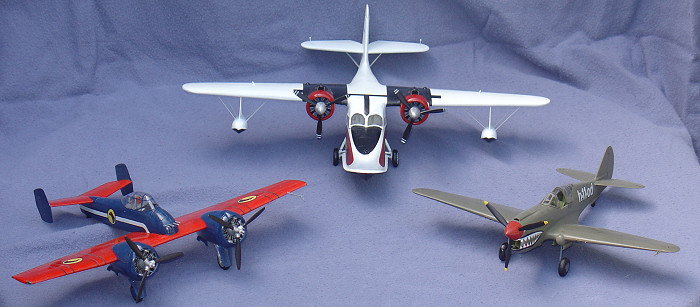
| KITS: | Minicraft XF5F, Czech Model Goose, ERTL P-40N |
| KIT #S: | 11626, 4812, 8798 |
| PRICE: | $15, 35, 7 |
| DECALS: | Blackhawk Website, Draw Decals, Jbot Decals |
| REVIEWER: | Dan Hamilton |
| NOTES: | Ah, to be a child once again. |

| REAL PLANES OF FICTIONAL HEROS |
For reasons that perhaps only mental health counselors can explain, I seem to like building models in sets -- like all the performance aircraft flown by the Blue Angels or the Thunderbirds for example. In so doing, I may not take great pride in my glacially developing modeling skills but am consoled by my dedication to historical accuracy (i.e. "Sure, it looks like crap, but its faithfully researched crap.") Strangely enough, this approach somehow still applied when I got the bug to build aircraft of some favorite fictional characters.
As odd is seems, the “fictional” aircraft I wanted to build all had a kind of “real” existence too -- if only perhaps in a drawing, on television or the movie screen -- and a faithful (oh, alright, "anal") modeler should find resources to guide him in such a modeling odyssey. Though my usual sources of Squadron, Osprey , Aircraft in Profile, etc., for some reason do not publish a series on fictional aircraft, luckily the airplanes that caught my imagination were all based on real machines. So, where the drawings, T.V. shows or movies were silent on the appearance of some particular aspect of these planes, the traditional resources were my guide. However, if the drawing, episode or film showed the hero's mount as being a certain way -- the “reel” version controlled regardless of what the manufacturer “really” built. It was the perfect storm for a modeler and wannabe pilot/adventurer such as myself -- I could have my head in the clouds yet keep my feet on familiar solid ground.
BLACKHAWK'S SKYROCKET
| HISTORY |
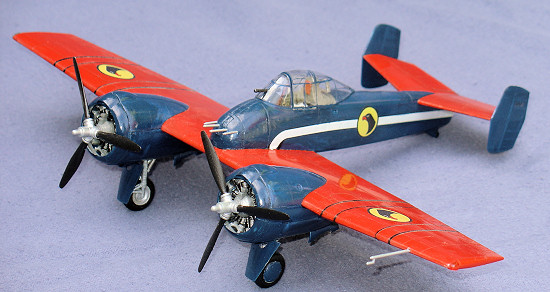 When
he first appeared in August of 1941, this comic book hero was an unnamed fighter
pilot in the air force of an unidentified nation (probably Poland) that was
quickly conquered by Nazi Germany. As the very last member of his squadron to
fight on until he was overwhelmed and shot down by the enemy’s hordes --
coincidentally over his own murdered family‘s farm (!) -- the unnamed pilot
stumbled out of his plane's wreckage only to return a few months later from his
private island (that he somehow acquired) calling himself "Blackhawk" (for some
reason) and leading a squadron of multinational pilots (e.g. from Sweden,
France, China, etc. ) to get revenge against the Axis -- kind of a flying Lone
Ranger without the mask and with League of Nations representatives instead of
Tonto. The comic’s hero became so popular he even made it to the highest
echelon of superheroes -- Blackhawk had his own movie serial (it was terrible
though, with the low budget film using far more cars than planes to get around
and those planes were mostly nondescript transports!)
When
he first appeared in August of 1941, this comic book hero was an unnamed fighter
pilot in the air force of an unidentified nation (probably Poland) that was
quickly conquered by Nazi Germany. As the very last member of his squadron to
fight on until he was overwhelmed and shot down by the enemy’s hordes --
coincidentally over his own murdered family‘s farm (!) -- the unnamed pilot
stumbled out of his plane's wreckage only to return a few months later from his
private island (that he somehow acquired) calling himself "Blackhawk" (for some
reason) and leading a squadron of multinational pilots (e.g. from Sweden,
France, China, etc. ) to get revenge against the Axis -- kind of a flying Lone
Ranger without the mask and with League of Nations representatives instead of
Tonto. The comic’s hero became so popular he even made it to the highest
echelon of superheroes -- Blackhawk had his own movie serial (it was terrible
though, with the low budget film using far more cars than planes to get around
and those planes were mostly nondescript transports!)
In the comics, however, the aircraft he and his men flew into their first decade of adventures was the Grumman XF5F Skyrocket -- though how they got them was never explained (perhaps, like the similarly rakish Flying Tigers‘ P-40‘s of that era, the Blackhawks also were part of a covert U.S. operation!) Ironically, this beautifully ugly but way cool Grumman fighter would combat the Nazis and Empire of Japan only in the comics. Though the real aircraft had first flown in April of 1940, only one prototype was built for reasons having more to do with the Navy's mind set against a big unconventional two engine fighter and less with the aircraft's generally impressive performance.
| THE KIT & ITS CONSTRUCTION |
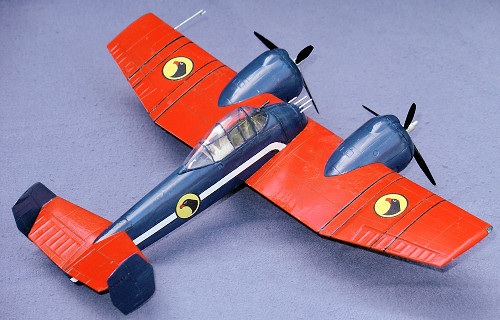 Having for some reason decided to build in 1/48 scale, Minicraft’s Skyrocket was
my only option. Though the model’s instructions noted the plane “became the
super weapon of ’Black Hawk‘ [sic],” it was no surprise that his decals were not
included as an option. The kit’s cockpit and landing gear compartment were
fairly primitive for this scale, but did allow for exposure of the fighter’s
four impressive 50 caliber guns if the “armament doors” were not cemented
closed. Unfortunately, I needed them closed and to say the doors do not come
together well is to put so much positive spin on it as to make even Karl Rove
dizzy. Beyond this major frustration that caused more glue on my fingers than
on the perpetually non joining nose parts, its assembly was otherwise straight
forward. (“Other than that Mrs. Lincoln, how was the play?”)
Having for some reason decided to build in 1/48 scale, Minicraft’s Skyrocket was
my only option. Though the model’s instructions noted the plane “became the
super weapon of ’Black Hawk‘ [sic],” it was no surprise that his decals were not
included as an option. The kit’s cockpit and landing gear compartment were
fairly primitive for this scale, but did allow for exposure of the fighter’s
four impressive 50 caliber guns if the “armament doors” were not cemented
closed. Unfortunately, I needed them closed and to say the doors do not come
together well is to put so much positive spin on it as to make even Karl Rove
dizzy. Beyond this major frustration that caused more glue on my fingers than
on the perpetually non joining nose parts, its assembly was otherwise straight
forward. (“Other than that Mrs. Lincoln, how was the play?”)
No real modifications to the kit were necessary for my version, other than leaving the arrester hook on the tree -- though Blackhawk did once land on a German aircraft carrier (!) lurking in the Gulf of Mexico (!), he apparently did so without the need of an arrester hook.
| COLORS & MARKINGS |
The first
problem is the markings -- where does one find decals for Blackhawk’s Skyrocket
and how much would I have to pay? Obviously, nothing -- they can be found for
free at Dan Thompson’s “Blackhawk” website! (
http://ourworlds.topcities.com/blackhawk/models/f5fmark.html )! Mr.
Thompson has graciously provided downloads and instructions on getting the
perfectly sized 1/72 or 1/48 scale Blackhawk decals from several of the
different schemes used by the
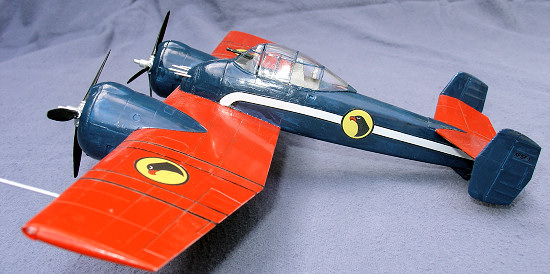 comic’s artists over the years. He also has some
great pictures of other modelers’ Blackhawk projects as well a wealth of
background information on his childhood hero.
comic’s artists over the years. He also has some
great pictures of other modelers’ Blackhawk projects as well a wealth of
background information on his childhood hero.
The second problem is that we are dealing with a drawing, not a real object, whose appearance (colors, markings and even the plane itself) would change at the whim of the particular artist -- sometimes from panel to panel. This was to be expected of course -- in the “golden age” of comics the artists had to quickly get the story done and move on to the next feature in that month‘s “Military Comics” and other publications if they were going to make a living. Accordingly, after doing some research by reading some very expensive reprints of the early series (i.e. “The Blackhawk Archives,” Vol. 1), I chose the January 1943 story where Blackhawk’s best artist Reed Crandal actually drew the Skyrocket as it looked in real life -- er, if real life had WWII fighters with blue fuselages and bright red wings! (If Blackhawk’s competitor Superman needed an airplane, this would have been the color scheme for it!). They must have needed to use bright colors in the comics for proper contrast, but in three dimensions the plane is pretty, er …, “cartoonish.”
| CONCLUSIONS |
Despite the model’s frustrating “armament doors,“ it was a blast making a 1940’s drawing come to life. Also, the unconventional research source of comic books was a great guilty pleasure! Heck, it’s a hobby most of us started as kids -- isn’t the point of it to be able to return to our childhood every once in a while?
| REFERENCES |
Blackhawk web site (http://ourworlds.topcities.com/blackhawk/models/f5fmark.html)
The Blackhawk Archives, Vol. 1, DC Archive Editions (2001)
James Steranko, The Steranko History of Comics, Vol. 2 (1972)
CUTTER’S GOOSE
| HISTORY |
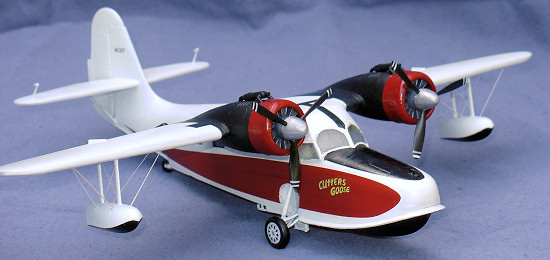 Soldier of fortune Jake Cutter (Stephen Collins, now of “7th
Heaven“), assisted by his faithful recovering alcoholic mechanic Corky (Jeff
Mackay, previously of “Baa Baa Black Sheep“) and not so loyal one eyed dog Jack,
struggled every week to rescue American spy Sarah White (Caitlin O'Heaney) from
various pre-world war two south pacific perils on ABC’s 1982-83 “Tales of the
Gold Monkey.” As much as I loved the cast in this fun T.V. version of Indiana
Jones -- and any show with Roddy McDowall as a world weary French bar owner
named “Bon Chance Loui” has got to be fun -- my heart always raced when they
took off in Jake’s Grumman Goose painted with the logo “Cutter’s Goose” on its
sides. (What is it about prewar Grumman aircraft that gets the heart
pounding?) Whether it was flying to mysterious unmapped islands in a fictional
prewar Japanese mandate, dodging into clouds to avoid strafing runs by Zeros, or
simply as a backdrop to emoting actors, the Goose for me was the real star of
the show. Though the series lasted only a single season and its attempts at
historical references were almost always embarrassing (for example, Jake was an
ex-Flying Tiger ace -- but the show was set before the war at a time when the
real Flying Tigers had yet to go into action!), “Tales” has deservedly become a
cult classic.
Soldier of fortune Jake Cutter (Stephen Collins, now of “7th
Heaven“), assisted by his faithful recovering alcoholic mechanic Corky (Jeff
Mackay, previously of “Baa Baa Black Sheep“) and not so loyal one eyed dog Jack,
struggled every week to rescue American spy Sarah White (Caitlin O'Heaney) from
various pre-world war two south pacific perils on ABC’s 1982-83 “Tales of the
Gold Monkey.” As much as I loved the cast in this fun T.V. version of Indiana
Jones -- and any show with Roddy McDowall as a world weary French bar owner
named “Bon Chance Loui” has got to be fun -- my heart always raced when they
took off in Jake’s Grumman Goose painted with the logo “Cutter’s Goose” on its
sides. (What is it about prewar Grumman aircraft that gets the heart
pounding?) Whether it was flying to mysterious unmapped islands in a fictional
prewar Japanese mandate, dodging into clouds to avoid strafing runs by Zeros, or
simply as a backdrop to emoting actors, the Goose for me was the real star of
the show. Though the series lasted only a single season and its attempts at
historical references were almost always embarrassing (for example, Jake was an
ex-Flying Tiger ace -- but the show was set before the war at a time when the
real Flying Tigers had yet to go into action!), “Tales” has deservedly become a
cult classic.
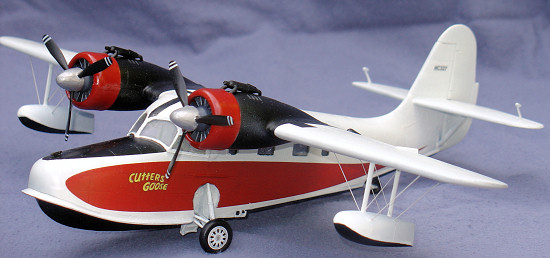 The
Goose used in the show has become somewhat of a cult classic itself. At one
time the oldest surviving Grumman amphibian still flying, this particular
seaplane tragically crashed and burned without loss of human life or limb in a
2005 taxiing accident. Hopefully it will be fully restored and the progress can
be tracked on the internet at http://www.drawdecal.com/goose/cuttersgoose.htm.
Even without the show, however, Grumman’s seaplane already had its fans.
Originally built in 1937 at the request of rich businessmen to get them to their
Long Island or Cuban holdings, it was also flown by the U.S. Army, Navy, Coast
Guard and Marines -- not to mention America’s pre and post war Allies -- for
utility, transport, rescue, photography and even bombing and depth charging. It
not only played the part of an adventurer’s aircraft, the Grumman Goose actually
flew in real life adventures.
The
Goose used in the show has become somewhat of a cult classic itself. At one
time the oldest surviving Grumman amphibian still flying, this particular
seaplane tragically crashed and burned without loss of human life or limb in a
2005 taxiing accident. Hopefully it will be fully restored and the progress can
be tracked on the internet at http://www.drawdecal.com/goose/cuttersgoose.htm.
Even without the show, however, Grumman’s seaplane already had its fans.
Originally built in 1937 at the request of rich businessmen to get them to their
Long Island or Cuban holdings, it was also flown by the U.S. Army, Navy, Coast
Guard and Marines -- not to mention America’s pre and post war Allies -- for
utility, transport, rescue, photography and even bombing and depth charging. It
not only played the part of an adventurer’s aircraft, the Grumman Goose actually
flew in real life adventures.
| THE KIT & ITS CONSTRUCTION |
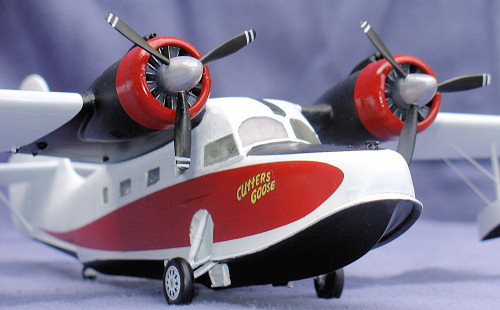 Czech
Model’s JRF Goose is a limited run kit with both plastic and resin pieces.
Though the detail is wonderful and allows “detailing for God” by a complete
passenger cabin that will never be seen by those without x-ray vision and a
cockpit that is only partially visible to the eyes of mere mortals, my first
experience at working with resin was not enjoyable. Several of the intricate
but brittle resin pieces came pre-broken in the box, and having to carefully saw
pieces off their base and mix epoxy every time I had to glue them was a chore.
Further, few observers will ever notice or care that I used the “bulging” resin
tires rather than the standard styrene plastic tires provided on the trees.
Czech
Model’s JRF Goose is a limited run kit with both plastic and resin pieces.
Though the detail is wonderful and allows “detailing for God” by a complete
passenger cabin that will never be seen by those without x-ray vision and a
cockpit that is only partially visible to the eyes of mere mortals, my first
experience at working with resin was not enjoyable. Several of the intricate
but brittle resin pieces came pre-broken in the box, and having to carefully saw
pieces off their base and mix epoxy every time I had to glue them was a chore.
Further, few observers will ever notice or care that I used the “bulging” resin
tires rather than the standard styrene plastic tires provided on the trees.
The lack of location pins on the plastic pieces also was an unpleasant experience -- I need all my skills just to make a regular model look half way decent and don’t need unnecessary challenges to my limited abilities. No matter the care I used, much filling and filing was necessary to hide that the fuselage halves were a millimeter off. I have seen builds of this model on the internet that were impressively seamless, but such craftsmanship with this kind of kit is still beyond me.
| COLORS & MARKINGS |
Numerous stills
from the show are available at a wonderful fan site -- goldmonkey.com -- at
which I spent much time selecting relevant photos to cut and past from the more
than a thousand thumbnails into a word document for easy and frequent reference
on my computer. Though other web cites had post show photos and drawings of
“Cutters Goose,” it appeared the scheme and some of the equipment had changed
after the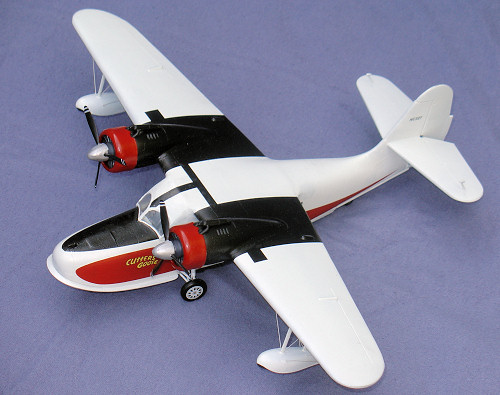 cancellation of the program (e.g. the wheels in the show were not the
standard JRF equipment shown in later photos on other sites).
cancellation of the program (e.g. the wheels in the show were not the
standard JRF equipment shown in later photos on other sites).
“Cutter’s Goose” decals were obtained for a reasonable price from “Draw Decals” and went on surprisingly well for a ham handed modeler like me. Do not follow the overhead paint scheme kindly provided with the decals, however -- photos from the show make clear the black painted portions on both sides of the wing of the “reel” Cutter’s Goose were not limited to the engine nacelles as shown in the illustration but extended to wide bands around the nacelles as well.
| CONCLUSIONS |
Again, the unconventional research technique of relying on numerous clips of a TV. show was a lot of fun. Though television executives may have killed a golden goose, I’m thrilled to have a 1/48 scale replica of it in my collection.
| REFERENCES |
http://www.goldmonkey.com/
http://www.drawdecal.com/goose/cuttersgoose.htm
www.drawdecal.com
Steve Ginter, Grumman Goose (2004)
SKYCAPTAIN’S P-40
| HISTORY |
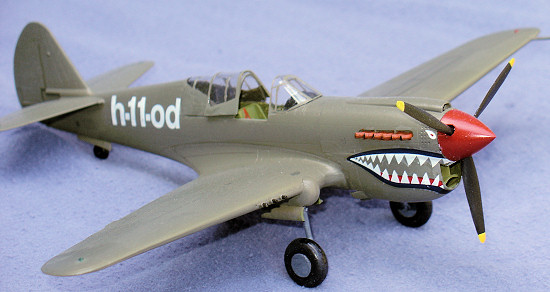 The
2004 movie “SkyCaptain and the World of Tomorrow” was set in a digitally
reproduced late 1930’s alternative world and was a homage to -- and an attempt
to stylishly recreate -- comics and movie serials of that time (the flying
robots are undeniably straight out of a Superman cartoon of the period). Sky
Captain (Jude Law) was a mysterious Blackhawk-like hero -- even down to his own
island full of warplanes and legion of pilots. SkyCaptain flew a specially
modified Curtiss P-40 (presumably a P-40N) that had non standard rappelling
hooks to fly sharp turns around corners in the canyons of buildings in New York
City as well as the hard to believe ability to quickly convert to an attack
submarine.
The
2004 movie “SkyCaptain and the World of Tomorrow” was set in a digitally
reproduced late 1930’s alternative world and was a homage to -- and an attempt
to stylishly recreate -- comics and movie serials of that time (the flying
robots are undeniably straight out of a Superman cartoon of the period). Sky
Captain (Jude Law) was a mysterious Blackhawk-like hero -- even down to his own
island full of warplanes and legion of pilots. SkyCaptain flew a specially
modified Curtiss P-40 (presumably a P-40N) that had non standard rappelling
hooks to fly sharp turns around corners in the canyons of buildings in New York
City as well as the hard to believe ability to quickly convert to an attack
submarine.
Ok, the plot was a bit hokey and the acting wooden -- after all, anything the actors didn’t touch was digitally created and how do you get the “method“ going against a blue screen? -- it was fun and stylish hokum. Most importantly though, its hero had a lot of screen time flying a P-40!
| THE KIT & ITS CONSTRUCTION |
I chose the ERTL P-40N because --well, let me be honest -- after spending so much money on the limited run Goose, this was the cheapest 1/48 Warhawk I could find on ebay. Though I spent much time, with limited success, trying to fill and sand its seams and attachment joints, it had a reasonably detailed cockpit that was a lot of fun to research in the traditional serious modeler‘s way. Unfortunately, I had to somewhat ruin its effect by modifying it to create an untraditional second seat behind the pilot where SkyCaptian’s love interest and star reporter “Polly Perkins” (Gwyneth Paltrow) sat in the movie.
| COLORS & MARKINGS |
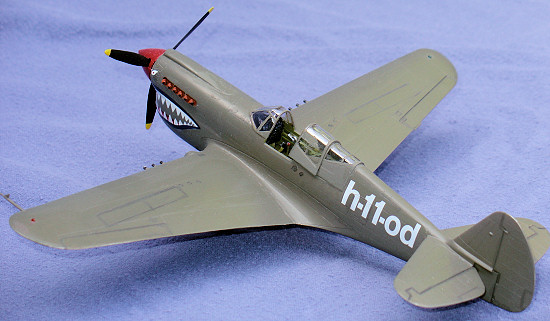 Not having been
a runaway smash in the 2004 movie season, there were not a lot of “SkyCaptian”
sites from which to pull out pictures of this fictional plane’s paint scheme.
However, after lobbying wife and family, I did get the DVD for Christmas.
Further, there were some web sites -- such as http://www.movieweb.com/movies/film/03/2303/gal1682/
-- where I could find limited stills of “Cap’s” P-40. Its paint scheme seemed
to be a darker version of the traditional olive drab -- understandable because
much of the film was made in cool sepia tones -- and its shark mouth was easy to
reproduce with the ERTL decals that came with the kit. The problem was the
unusual identification numbers and letters on the fuselage -- made up of small
case letters and dashes -- which had a special significance in the movie (I
won‘t give it away outright, but think upside down mirror writing). I’ve tried
painting markings before and at this scale it would not have been pretty.
Fortunately, a kind Canadian gentleman whom I assisted with the research on his
series of Blue Angel decals -- specifically Jim Botaitis of “Jbot Decals”
( http://www.jbot.ca/ ) -- generously made up a set of decals which worked
perfectly.
Not having been
a runaway smash in the 2004 movie season, there were not a lot of “SkyCaptian”
sites from which to pull out pictures of this fictional plane’s paint scheme.
However, after lobbying wife and family, I did get the DVD for Christmas.
Further, there were some web sites -- such as http://www.movieweb.com/movies/film/03/2303/gal1682/
-- where I could find limited stills of “Cap’s” P-40. Its paint scheme seemed
to be a darker version of the traditional olive drab -- understandable because
much of the film was made in cool sepia tones -- and its shark mouth was easy to
reproduce with the ERTL decals that came with the kit. The problem was the
unusual identification numbers and letters on the fuselage -- made up of small
case letters and dashes -- which had a special significance in the movie (I
won‘t give it away outright, but think upside down mirror writing). I’ve tried
painting markings before and at this scale it would not have been pretty.
Fortunately, a kind Canadian gentleman whom I assisted with the research on his
series of Blue Angel decals -- specifically Jim Botaitis of “Jbot Decals”
( http://www.jbot.ca/ ) -- generously made up a set of decals which worked
perfectly.
| CONCLUSIONS |
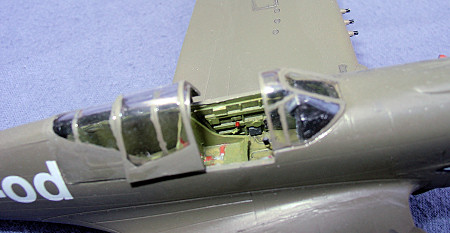 Having made so many P-40’s as a kid -- almost all of them Flying Tiger versions
-- I’ve got to admit this was the least exciting of the three to build.
Nevertheless, as previously noted, there’s just something kid-like -- and
therefore liberating -- about making a perfectly frivolous pseudo-historical
model for a change.
Having made so many P-40’s as a kid -- almost all of them Flying Tiger versions
-- I’ve got to admit this was the least exciting of the three to build.
Nevertheless, as previously noted, there’s just something kid-like -- and
therefore liberating -- about making a perfectly frivolous pseudo-historical
model for a change.
| REFERENCES |
“SkyCaptiain and the World of Tomorrow,” DVD (2004)
http://www.movieweb.com/movies/film/03/2303/gal1682/
Glen Phillips and Kevin Hjermstad, Building The P-40 Warhawk (1997)
If you would like your product reviewed fairly and quickly by a site that has over 300,000 visitors a month, please contact me or see other details in the Note to Contributors.